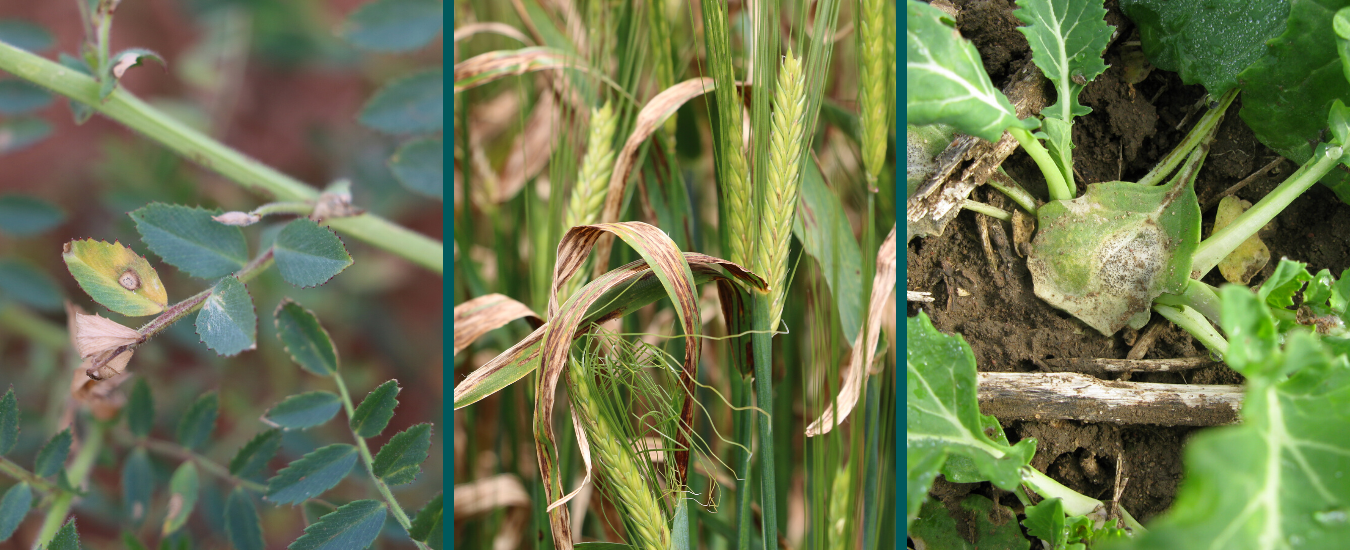The following papers were presented at the GRDC Updates in Bendigo in February 2021. This article includes a summary of key points from each paper, click on the title to find the full text.
Cereal disease update 2021
Authors: Mark McLean, Grant Hollaway and Hari Dadu (Agriculture Victoria), Robert Park (The University of Sydney), Art Diggle (DPIRD) and Kylie Ireland (Centre for Crop and Disease Management).
- Proactive disease management that combines options (such as variety selection, paddock selection and appropriate fungicide use) provides proven sustainable and economic control of cereal diseases.
- Stripe rust is likely to be important during 2021 especially where summer rain supports disease carry over. Field experiments found the new StripeRustWM App to be a useful tool to support in-crop fungicide decisions.
- Mixed infection with both spot form of net blotch (SFNB) and net form of net blotch (NFNB) in the Wimmera and Mallee decreased the yield of susceptible barley varieties by 9% and 20%, respectively, demonstrating the benefit of control in disease conducive seasons.
- Red leather leaf was the most common disease of oats in Victoria. During 2020, it reduced hay yield by 10 to 13% and grain yield by 15 to 20% demonstrating the need to implement control strategies.
- Development of fungicide resistance is increasing in cereal pathogens but can be slowed through adoption of integrated control strategies and prudent use of fungicides.
Pulse disease research update
Authors: Joshua Fanning, Jason Brand, Grant Hollaway (Agriculture Victoria), James Manson (Southern Farming Systems), Blake Gontar (SARDI).
- Selecting a more resistant variety will reduce grain yield losses caused by disease.
- The faba bean, PBA Amberley will require fungicide application to prevent grain yield losses.
- Fungicide strategies incorporating newer fungicide actives are providing equal or better disease control than older actives in faba bean and chickpea.
- Applying fungicides to prevent ascochyta blight in chickpea when grain yields are above 0.5t/ha resulted in an economic advantage in field experiments.
- Inter-row sowing into standing cereal stubble, compared to slashed stubble, is almost as effective at reducing chickpea grain yield losses due to ascochyta blight, as choosing a moderately susceptible variety compared to a susceptible variety.
- Numerous pathogens have been detected in pulse roots, and many Fusarium spp. and Phoma/Didymella spp. have been shown to cause root disease.
Root disease in pulses – cause of poor performance?
Authors: Blake Gontar, Tara Garrard, Kelly Barnett, Entesar Abood and Alan Mckay (SARDI)
- Root disease is common in pulses and appears to be causing varying levels of yield loss.
- Five hundred and thirty-three pulse root survey samples were assessed in 2020, building on previous work. Pythium, root lesion nematode, Phoma pinodellaand Rhizoctonia solani AG8 are common across a range of pulses.
- Less common but potentially more damaging Aphanomyces and Phytophthora continue to be detected; these are found across Australia but only infrequently at this stage.
- Partial control of root disease in field trials in 2020 corresponded with yield increases of up to 0.62t/ha. Pulse root diseases are likely to be having significant yield impacts across Australia.
Vetch disease management
Authors: Joshua Fanning, Mitchell Fromm, Jason Brand (Agriculture Victoria) and Stuart Nagel (SARDI)
- Grain yield losses in vetch of on average of 26% were observed in plots with no disease control.
- Selecting resistant varieties and applying foliar fungicides will reduce grain yield losses.
Will I get an economic response from applying fungicide to canola for the control of blackleg?
Authors: Steve Marcroft (Marcroft Grains Pathology), Angela Van de Wouw (School of BioSciences, University of Melbourne), Susie Sprague (CSIRO) Andrew Ware (EPAG Research), Kurt Lindbeck (NSW DPI), Andrew Wherret (Livingfarm), Andrea Hills (DPIRD) and Nick Perndt (Marcroft Grains Pathology).
- The canola industry has become more reliant on fungicides to control blackleg, in some regions there is reduced emphasis on cultural practices to reduce disease.
- The decision to use a fungicide is not clear cut and should be based on the disease risk profile of the crop.
- Severe blackleg crown canker occurs when plants are infected during early seedling growth. Prior to sowing, use the BlacklegCM decision support tool to identify high risk paddocks and explore management strategies to reduce yield loss.
- Early vegetative (4-10 leaf) foliar fungicide application should be based on the risk profile of the crop, cultivar blackleg rating and estimation of the potential yield after scouting for leaf lesions.
- Fungicide application decision-making for upper canopy infection is separate to the decision process for crown canker. Fungicide applications to control upper canopy infection can result in variable yield responses. It is important to understand the disease risk before applying a fungicide.
- Knowledge on upper canopy infection is improving and it is likely that decision making will become more reliable. A decision support tool is expected to be released via GRDC investment when there is sufficient confidence on recommendations to aid decision making.
Further information links
- For a full copy of the 2021 Bendigo GRDC Grains Research Update proceedings
- 2021 disease guides for Victoria – Pulses and Cereals
- Blackleg Management Guide
- 2021 Victorian Crop Sowing Guide
- StripeRustWM app – A pathologist in your pocket



